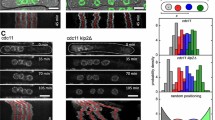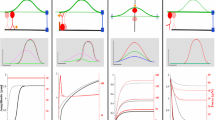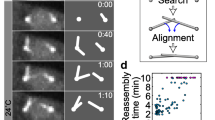Summary
In several cell types, an intriguing correlation exists between the position of the centrosome and the direction of cell locomotion. The centrosome is positioned between the leading edge pseudopod and the nucleus. This suggests that the polarized distribution of organelles in the cytoplasm is coupled spatially with structural and functional polarity in the cell cortex. To study cellular polarization with special interest in the roles of microtubules, we have analyzed the effects of microtubule-disrupting reagents and local laser irradiation on behaviors of both the nucleus and the centrosome in living amoebae ofPhysarum polycephalum. Physarum cells often have 2–3 pseudopods. One of the pseudopods keeps extending to become a stable leading edge while the rest retracts, a crucial step that reorients cells during locomotion. The nucleus, together with the centrosome, moves specifically toward the pseudopod that will become the leading edge. Disruption of microtubules with nocodazole randomizes positions of the nucleus, indicating the involvement of microtubules in the directional migration of the nucleus toward a specific pseudopod. The migration direction of the nucleus is reversed immediately after the UV laser is irradiated at regions between the nucleus and the future leading pseudopod. In contrast, irradiation at regions between the future tail and the nucleus does not affect nuclear migration. By immunofluorescence, we confirmed fragmentation of microtubules specifically in the irradiated region. These results suggest that the nucleus is pulled together with the centrosome toward the future leading-edge pseudopod in a microtubule-dependent manner. Microtubules seem to exert the pulling force generated in the cell cortex on the centrosome. They may serve as a mediator of shape changes initiated in the cell cortex to the organelle geometry in the endoplasm.
Similar content being viewed by others
References
Aist JR, Bayles CJ, Tao W, Berns MW (1991) Direct experimental evidence for the existence, structural basis and function of astral forces during anaphase B in vivo. J Cell Sci 100: 279–288
Bray D (1992) Cell movements. Garland Publishing, New York
Carminati JL, Stearns T (1997) Microtubules orient the mitotic spindle in yeast through dynein-dependent interactions with the cell cortex. J Cell Biol 138: 629–641
Euteneuer U, Schliwa M (1985) Evidence for an involvement of actin in the positioning and motility of centrosomes. J Cell Biol 101: 96–103
— — (1992) Mechanism of centrosome positioning during the wound response in BSC-1 cells. J Cell Biol 116: 1157–1166
Fygenson DK, Elbaum M, Shraiman B, Libchaber A (1997) Micro-tubules and vesicles under controlled tension. Phys Rev E 55: 850–859
Gotlieb AI, May LM, Subrahmanyan L, Kalnins VI (1981) Distribution of microtubule organizing centers in migrating sheets of endothelial cells. J Cell Biol 91: 589–594
Griffith LM, Pollard TD (1982) The interaction of actin filaments with microtubules and microtubule-associated proteins. J Biol Chem 257: 9143–9151
Heidemann SR, Buxbaum RE (1990) Tension as a regulator and integrator of axonal growth. Cell Motil Cytoskeleton 17: 6–10
Hiramoto Y, Nakano Y (1988) Micromanipulation studies of the mitotic apparatus in sand dollar eggs. Cell Motil Cytoskeleton 10: 172–184
Hirokawa N (1998) Kinesin and dynein superfamily proteins and the mechanism of organelle transport. Science 279: 519–526
Hyman AA (1989) Centrosome movement in the early divisions ofCaenorhabditis elegans: a cortical site determining centrosome position. J Cell Biol 109: 1185–1193
Ingber DE (1993) Cellular tensegrity: defining new rules of biological design that govern the cytoskeleton. J Cell Sci 104: 613–627
—, Dike L, Hansen L, Karp S, Liley H, Maniotis A, McNamee H, Mooney D, Plopper G, Sims J, Wang N (1994) Cellular tensegrity: exploring how mechanical changes in the cytoskeleton regulate cell growth, migration, and tissue pattern during morphogenesis. Int Rev Cytol 150: 173–224
Kaech S, Ludin B, Matus A (1996) Cytoskeletal plasticity in cells expressing neuronal microtubule-associated proteins. Neuron 17: 1189–1199
Kalnins VI, Rogers K (1992) The centrosome in stationary and migrating endothelial cells. In: Kalnins VI (ed) The centrosome. Academic Press, San Diego, pp 287–312
Kamiya N, Kuroda K (1965) Movement of the myxomycete plasmodium I: a study of glycerinated models. Proc Jpn Acad 41: 837–841
Kupfer A, Louvard DD, Singer SJ (1982) Polarization of the golgi apparatus and the microtubule-organizing center in cultured flbroblasts at the edge of an experimental wound. Proc Natl Acad Sci USA 79: 2603–2607
Lutz DA, Hamaguchi Y, Inoue S (1988) Micromanipulation studies of the asymmetric positioning of the maturation spindle inChaetopterus sp. oocytes I: anchorage of the spindle to the cortex and migration of a displaced spindle. Cell Motil Cytoskeleton 11: 83–96
Mitchison TJ, Kirschner M (1984) Dynamic instability of microtubule growth. Nature 312: 237–242
Neujahr R, Albrecht R, Kohler J, Matzner M, Schwartz JM, Westphal M, Gerisch G (1998) Microtubule-mediated centrosome motility and the positioning of cleavage furrows in multinucleate myosin II-null cells. J Cell Sci 111: 1227–1240
Osborn M, Weber K (1976) Cytoplasmic microtubules in tissue culture cells appear to grow from an organizing structure towards the cell membrane. Proc Natl Acad Sci USA 73: 867–871
Rodionov VI, Borisy GG (1997) Self-centring activity of cytoplasm. Nature 386: 170–173
—, Gyoeva FK, Tanaka E, Bershadsky AD, Vasiliev JM, Gelfand VI (1993) Microtubule-dependent control of cell shape and pseudopodial activity is inhibited by the antibody to kinesin motor domain. J Cell Biol 213: 1811–1820
Schliwa M (1992) Cell polarity and centrosome. In: Kalnins VI (ed) The centrosome. Academic Press, San Diego, pp 331–351
—, Höner B (1993) Microtubules, centrosomes, and intermediate filaments in directed cell movement. Trends Cell Biol 3: 377–380
—, van Blerkom J (1981) Structural interaction of cytoskeletal components. J Cell Biol 90: 222–235
—, Euteneuer U, Gräf R, Ueda M (1999) Centrosomes, microtubules, and cell movement. Biochem Soc Symp 65: 223–231
Singer SJ, Kupfer A (1986) The directed migration of eucaryotic cells. Annu Rev Cell Biol 2: 337–365
Tanaka EM, Kirschner MW (1991) Microtubule behavior in the growth cones of living neurons during axon elongation. J Cell Biol 115: 345–363
Taylor DL, Condeelis JS (1979) Cytoplasmic structure and contractility in amoeboid cells. Int Rev Cytol 56: 57–144
Ueda M, Ogihara S (1994) Microtubules are required in amoebae chemotaxis for preferential stabilization of appropriate pseudopods. J Cell Sci 107: 2071–2079
—, Gräf R, MacWilliams HK, Schliwa M, Euteneuer U (1997) Centrosome positioning and directionality of cell movements. Proc Natl Acad Sci USA 94: 9674–9678
Vasiliev JM (1987) Actin cortex and microtubular system in morphogenesis: cooperation and competition. J Cell Sci Suppl 8: 1–18
—, Gelfand IM, Domnina LV, Ivanova OY, Komm SG, Olshevskaja LV (1970) Effect of colcemid on the locomotory behavior of fibroblasts. J Embryol Exp Morphol 24: 625–640
Waterman-Storer CM, Worthylak RA, Liu BP, Burridge K, Salmon ED (1999) Microtubule growth activates Racl to promote lamellipodial protrusion in fibroblasts. Nat Cell Biol 1: 45–50
Yumura S, Mori H, Fukui Y (1984) Localization of actin and myosin for the study of amoeboid movement in Dictyostelium using improved immunofluorescence. J Cell Biol 99: 233–242
Author information
Authors and Affiliations
Rights and permissions
About this article
Cite this article
Ueda, M., Kuroiwa, T., Matsunaga, S. et al. Microtubule-dependent migration of the cell nucleus toward a future leading edge in amoebae ofPhysarum polycephalum . Protoplasma 211, 172–182 (2000). https://doi.org/10.1007/BF01304485
Received:
Accepted:
Issue Date:
DOI: https://doi.org/10.1007/BF01304485




